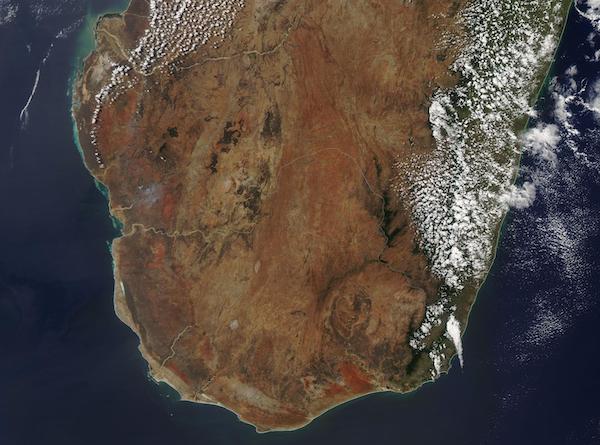Images
September 27, 2020 - Madagascar
Tweet
Stunning sienna and umbers dominate the dry-season landscape of southern Madagascar. The Moderate Resolution Spectroradiometer (MODIS) on board NASA’s Aqua satellite acquired a true-color image of the region on September 25.
In southwestern Madagascar the dominant climate is dry and desert-like. Even the wet season (November to April) brings little rain. Here plants have adapted to the unique, dry, sandstone-rich biome so completely that many are unlike any others on Earth. Many species sport small leaves and spines which allow them to retain water extremely well, much like succulents that are at home in deserts. Yet many also have tall trunks, giving them more the appearance of trees. The Madagascar Spiny Thicket is vulnerable to damage from human activity and at risk for deforestation.
In sharp contrast, the southeastern coast of Madagascar receives substantially more rainfall, giving rise to green forests, also filled with unique flora and fauna. In this image, the rain forest lies under a light cover of “popcorn” cloud – a type of cloud that commonly forms over moist, green forest.
Image Facts
Satellite:
Aqua
Date Acquired: 9/25/2020
Resolutions:
1km (257.7 KB), 500m (257.7 KB), 250m (797.6 KB)
Bands Used: 1,4,3
Image Credit:
MODIS Land Rapid Response Team, NASA GSFC
Tweet
Stunning sienna and umbers dominate the dry-season landscape of southern Madagascar. The Moderate Resolution Spectroradiometer (MODIS) on board NASA’s Aqua satellite acquired a true-color image of the region on September 25.
In southwestern Madagascar the dominant climate is dry and desert-like. Even the wet season (November to April) brings little rain. Here plants have adapted to the unique, dry, sandstone-rich biome so completely that many are unlike any others on Earth. Many species sport small leaves and spines which allow them to retain water extremely well, much like succulents that are at home in deserts. Yet many also have tall trunks, giving them more the appearance of trees. The Madagascar Spiny Thicket is vulnerable to damage from human activity and at risk for deforestation.
In sharp contrast, the southeastern coast of Madagascar receives substantially more rainfall, giving rise to green forests, also filled with unique flora and fauna. In this image, the rain forest lies under a light cover of “popcorn” cloud – a type of cloud that commonly forms over moist, green forest.
Image Facts
Satellite:
Aqua
Date Acquired: 9/25/2020
Resolutions:
1km (257.7 KB), 500m (257.7 KB), 250m (797.6 KB)
Bands Used: 1,4,3
Image Credit:
MODIS Land Rapid Response Team, NASA GSFC




